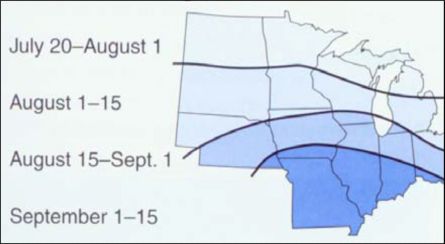Keys to Success
Late summer can be an excellent time to establish alfalfa and can result in excellent and productive stands next spring.
There are two critical risks associated with summer seeding alfalfa. First, seeding too early in the summer increases the risk of hot, dry conditions during germination and seedling development. Summer seedings fail if seeds germinate and then starve for moisture.
A second major risk is seeding too late in the summer. Late seedings increase the chance of a killing frost injuring alfalfa seedlings before they are adequately established. Seeding must be done early enough so that the alfalfa can accumulate sufficient root reserves to survive the winter.
There are several key recommendations to successfully establish alfalfa in late summer.
Plant six weeks before first killing frost..
1. Alfalfa needs 45 days (6+ weeks) growth from germination to the first killing frost to survive the winter. This allows for build-up of adequate carbohydrate root reserves for winter survival. Never attempt to harvest the fall alfalfa growth.

Eliminate weed competition.
2. Use a burndown herbicide like glyphosate to control perennial weeds or volunteer small grains prior to planting. Use of a glyphosate tolerant alfalfa variety gives you additional options for weed control after establishment.
Lime and fertilize before planting.
3. Before summer planting, have your soil tested, and follow lime and fertilizer recommendations for phosphorus (P), potassium (K), and sulfur (S). The optimum pH level is 6.8, and liming should occur 6 to 24 months prior to planting. Maintaining P levels is critical to proper root and seedling development, while K increases yields and stand persistence
Direct seed alfalfa for best success.
4. Companion crops compete for sunlight and moisture. At this time of year, any competition will risk seeding failure. If a companion crop is needed for erosion, control plant oats at one-half bushel per acre.
Plant when soil conditions are right.
5. Avoid planting alfalfa seed into extremely dry soil with little chance of rain in the near-term forecast. New seedlings may emerge, but can die within a matter of days from heat and droughty soils.
Monitor seeding depth.
6. Ideal planting depth for alfalfa in clay or loam soils is 1⁄4 to 1⁄2 inch. For light or sandy soils, seeds should be place at 1⁄2 to 3⁄4 inch deep. Once worked, soils will dry quicker in late summer. Pack soils firmly to help control seeding depth. Press wheels behind a drill give the best stand establishment. A roller or packer can also work.
Plant winterhardy, disease resistant varieties.
7. Choose varieties that are resistant to all major alfalfa diseases in your area. Seedling diseases are not as important in the late summer seeding as for spring seeding, but major diseases and winterhardiness are still key factors for persistence.
Maintain normal seeding rates.
8. Plant alfalfa at 15-18 lbs. per acre to ensure an adequate stand. Summer seedlings can be susceptible to loss under dry conditions. Use the higher seeding rate when soils are on the dry side.
Don’t reseed into old alfalfa stands.
9. Alfalfa plants produce a toxin that can reduce root development and survival of new seedlings. If you are reseeding into a previous alfalfa stand, you need a waiting period to make sure all toxin is degraded out of the root zone. You can reseed immediately into a failed spring seeding (or from the previous fall). If an alfalfa stand is more than one year old, don’t attempt to reseed for at least one year.
While late summer seedings have some risks, they offer many advantages for establishing strong, productive alfalfa stands on your farm.